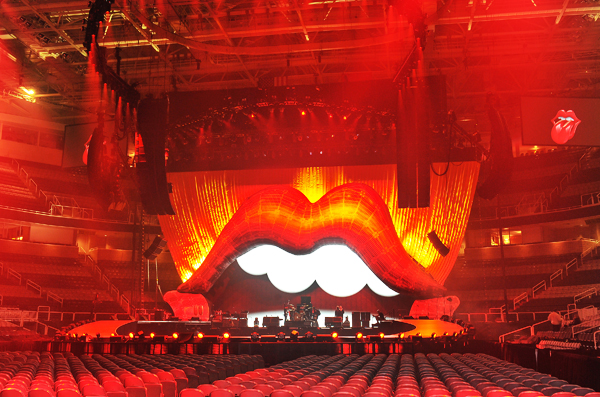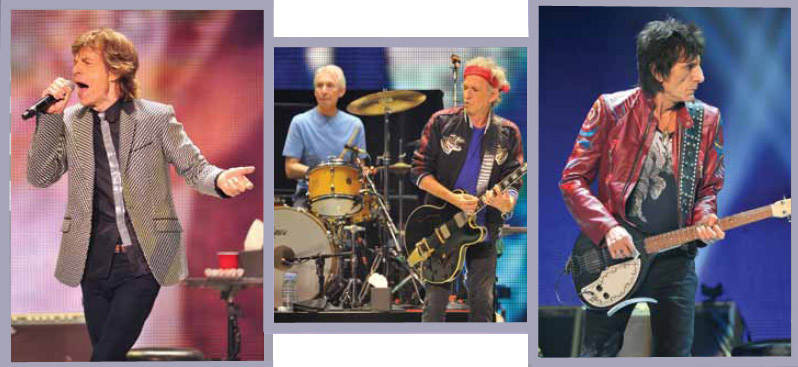
Honed Perspective
With more than 40 years on tour and literally countless shows, it seems unfair to characterize Jo Ravich as simply the FOH systems tech. I think of him more as a distinguished master—he offers a degree of wisdom and perspective honed from years on the road that few of us will ever attain. He distills the risks of using gear unnecessarily in very simple terms: “Just because you can use 25 plug-ins doesn’t mean you should.”
Clair Global crew chief Thomas Huntington offers his perspective: “We try to change as little as possible from show to show, and how we set the PA up is fairly standard and consistent. How Dave and Jo approach using subs is brilliant. They don’t use any ground subs, because often what happens is you either turn them off or EQ out all of the low-frequency energy anyway, because we’re in a big boom chamber with no articulation. This is rock ‘n’ roll, it’s not thumpy modern drill your head stuff. We have a varied demographic, and some of our fans don’t care to hear all that extended low end.”
“Subs are for sissies anyway,” Natale chimes in. “No sexy lightweight amps either on this tour. We’re using Crown Macro-Tech because I’m interested in having fully charged capacitors at all times,” indicating his preference for a more traditional amplifier power supply topology. “I use old Lake Contour processors because I know them so well. One XTA GQ600 stereo third-octave EQ sits between the console outputs and the system processors.”
Incredibly Rewarding
Robert Bull handles the monitor mixing duties for the tour. A Nashville veteran who for years has been Martina McBride’s monitor engineer, this is his first outing with the Stones.
As expected, he’s mixing a combination of in-ears and wedges. What’s not expected is that he handles the monitor effort for the entire band himself on one 48-channel Midas Heritage 4000. This was a task previously handled by two engineers, and when I observed him working during the show, he’s a very busy man.
Despite the magnitude of the show, Bull approaches it in a down-to-earth manner. “Everything is very analog and very simple, although it’s a really busy show with lots of cues. Mick, (bassist) Daryl Jones, and our two backup singers, Bernard and Lisa, are on ears. We have 52 wedges as well as flown side fills. Charlie uses a pair of 12AMs (wedges) stacked on two i5B subs. On ‘Sympathy for the Devil’ he uses headphones.”
Bull shares the team’s strict minimalist mantra, with no noise gates or compressors for the band’s monitors, only for guest artists. Effects are limited to two reverbs. I found his demeanor with respect to this tour both humbling and respectful. “To be brutally honest, it’s the most stressful thing I’ve ever done, but incredibly rewarding,” he says. “It’s fun to mix. These guys deserve the best, and sometimes the fact that I’m sitting in the monitor seat is overwhelming.”
He notes that the downstage mix is pretty much a blend. “Keith’s guitar is a bit louder stage left, Ronnie’s louder stage right. Mick has two wedges he can rely on if for some reason he’s uncomfortable with his ears. Stage levels are pretty loud. Keith’s guitar level dictates everything.”
I could go into greater depth on the house PA, but suffice it to say it’s comprised of large, very well-tuned Clair i5 line arrays. Coincidentally, on my return trip from the show, I ran into Clair Global CEO Troy Clair at the Denver airport. I told him how good the show had sounded to me, and stressed how amazed I was that Dave, Jo, Thomas, Robert and their associates were getting these results with a healthy dose of moderation using no dynamics control whatsoever. I came away thinking that he too appreciates that there is real virtue in restraint.
The approach might leave many younger engineers scratching their heads, aghast if saddled with these simple and economical equipment choices, wondering “how do they make this work?” I argue that the Rolling Stones crew do it by listening.
Danny Abelson is a co-founder of Zeehi, a new company developing the online digital console file conversion software service CueCast. Now in public Beta release, sign up for CueCast at www.cuecast.com.


